Moroccan Desserts and Sweets: A Deliciously Sweet Tradition
Moroccan desserts and sweets hold a special place in the country’s rich culinary heritage and cultural traditions. They are not just delightful treats but symbols of hospitality, celebration, and community. Whether served during festive occasions like Ramadan, Eid, weddings, or simply as an everyday indulgence alongside a steaming glass of Moroccan mint tea, these sweets embody centuries of craftsmanship, unique ingredients, and a passion for flavor.
The variety of Moroccan desserts is vast and reflects the diverse cultural influences that have shaped the region from Berber to Arab, Andalusian, and French. Moroccan sweets often combine fragrant spices, nuts, honey, and floral waters to create layered flavors and textures that surprise and delight the palate.
In this article, we’ll explore some of the most iconic Moroccan desserts, their key ingredients, regional variations, and the traditions surrounding their preparation and consumption. Get ready to discover a deliciously sweet tradition that is as rich in meaning as it is in taste.
Key Ingredients in Moroccan Sweets
The magic of Moroccan desserts comes from a harmonious blend of simple yet flavorful ingredients, many of which have been used for centuries to create distinctive tastes and textures.
1. Almonds:
Almonds are a cornerstone of Moroccan sweets. Often ground into a fine paste or used whole, they add richness, texture, and a subtle nutty flavor. Almonds are the base for iconic pastries like M’hanncha and Kaab el Ghazal.
2. Honey:
Moroccan honey, sometimes infused with local herbs or flowers, is used both as a sweetener and a glaze. It imparts a deep, natural sweetness and sticky texture to desserts like Chebakia and Sellou.
3. Sesame Seeds:
These tiny seeds provide a nutty crunch and are commonly sprinkled on sweets or incorporated into dough. Sesame seeds are particularly prominent in Chebakia.
4. Orange Blossom Water and Rose Water:
Floral waters are a hallmark of Moroccan cuisine. They add a delicate, fragrant aroma and unique flavor that elevate simple ingredients into something truly special. Orange blossom water is especially common in almond-based pastries.
5. Dates, Figs, and Dried Fruits:
Dates and figs are often used to add natural sweetness and chewy texture. They reflect Morocco’s agricultural abundance and are popular in both desserts and snacks.
6. Spices:
Cinnamon, saffron, anise, and sometimes ginger are used sparingly but effectively to add warmth and complexity. These spices create layers of flavor that distinguish Moroccan sweets from those of other regions.
7. Phyllo Pastry and Semolina:
Light, flaky phyllo dough is used to wrap fillings or create layered pastries, while semolina is common in cakes and puddings, offering a coarse texture and nutty taste.
Together, these ingredients create Moroccan desserts that are rich, aromatic, and full of contrasting textures—from crispy and crunchy to soft and moist.
INDULGE IN MOROCCO’S MOST DELICIOUSLY SWEET TRADITIONS
From flaky almond-filled briouats to sticky honey-drenched chebakia, Moroccan desserts are a feast for the senses. Rooted in centuries of culinary heritage, these sweets blend warm spices, nuts, and floral waters into irresistible treats. Whether enjoyed with mint tea or during festive celebrations, each bite tells a story of tradition, hospitality, and pure indulgence.
Classic Moroccan Desserts
Moroccan desserts showcase a beautiful balance of sweetness, texture, and aromatic spices. Many of these treats have been passed down through generations and are often tied to special occasions and family gatherings. Here are some of the most beloved traditional Moroccan sweets:
1. Chebakia:
Chebakia is a popular fried pastry especially prepared during Ramadan. The dough is shaped into intricate flower-like forms, deep-fried until golden and crispy, then coated generously with honey and sprinkled with toasted sesame seeds. The combination of crunchy texture and sticky sweetness makes Chebakia irresistible and deeply satisfying after a day of fasting.
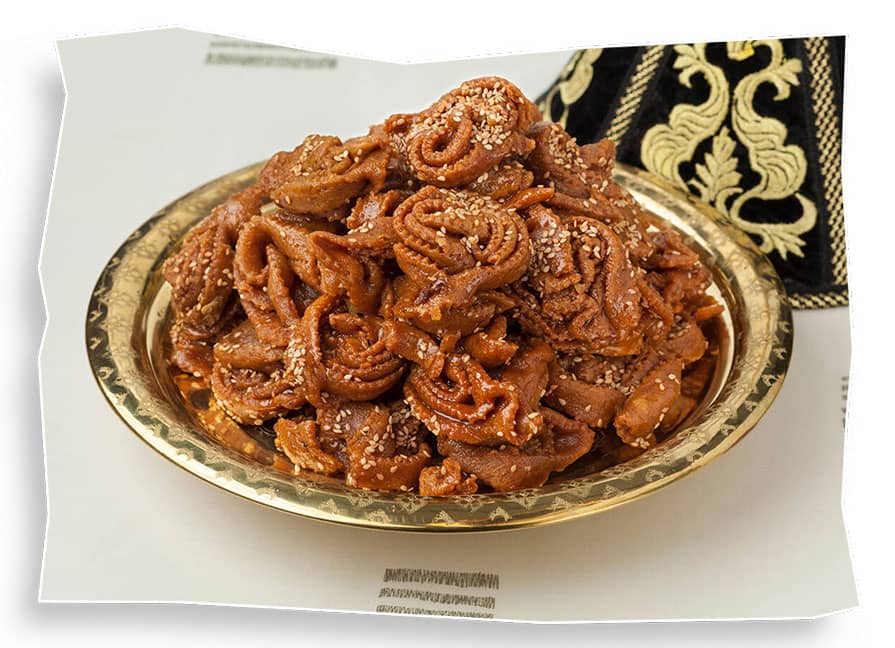
2. M’hanncha (The Snake Cake):
Named for its coiled, snake-like shape, M’hanncha is a stunning dessert made by wrapping almond paste flavored with orange blossom water inside thin layers of phyllo pastry. After baking, it is dusted with powdered sugar and sometimes decorated with rose petals or nuts. This dessert combines flaky, buttery layers with a sweet, fragrant filling, making it a showstopper at celebrations.
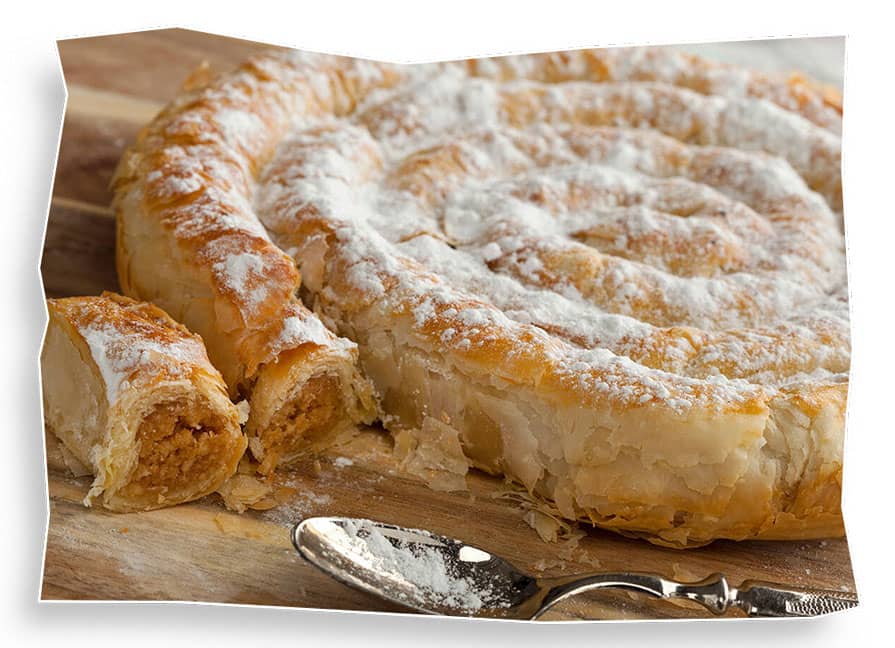
3. Sellou (Sfouf):
Sellou is a dense, energy-packed sweet made from toasted semolina flour mixed with ground almonds, sesame seeds, anise, and spices like cinnamon, all bound together with honey and butter. It is traditionally served at weddings and religious holidays, symbolizing prosperity and happiness. Sellou’s rich, nutty flavor and crumbly texture make it a unique Moroccan treat.
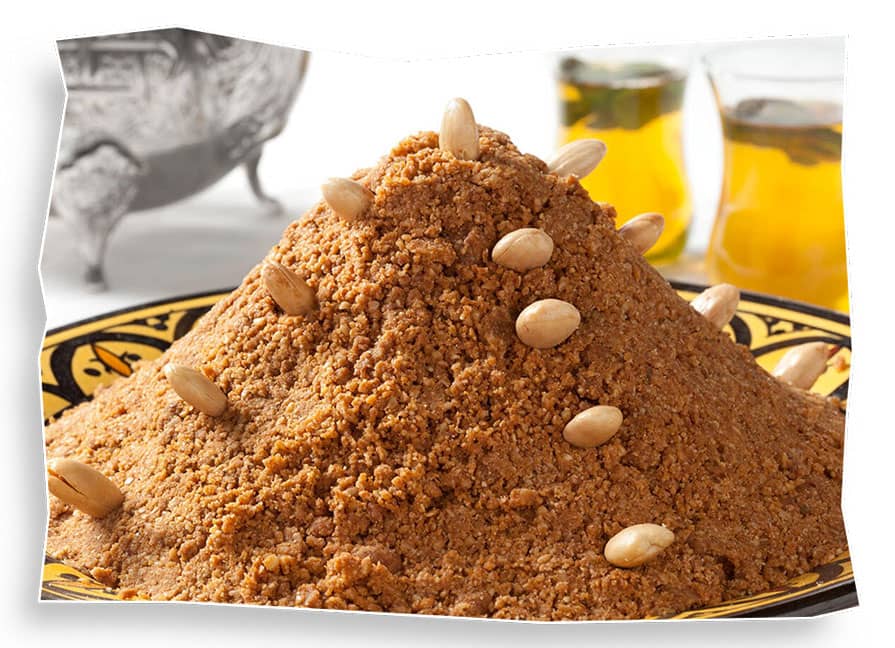
4. Ghriba:
Ghriba refers to a variety of Moroccan cookies that are soft and crumbly, often made from ground almonds or coconut. These cookies have a melt-in-the-mouth texture and are sometimes flavored with orange blossom water or cinnamon. They are enjoyed year-round and are a favorite accompaniment to Moroccan tea.
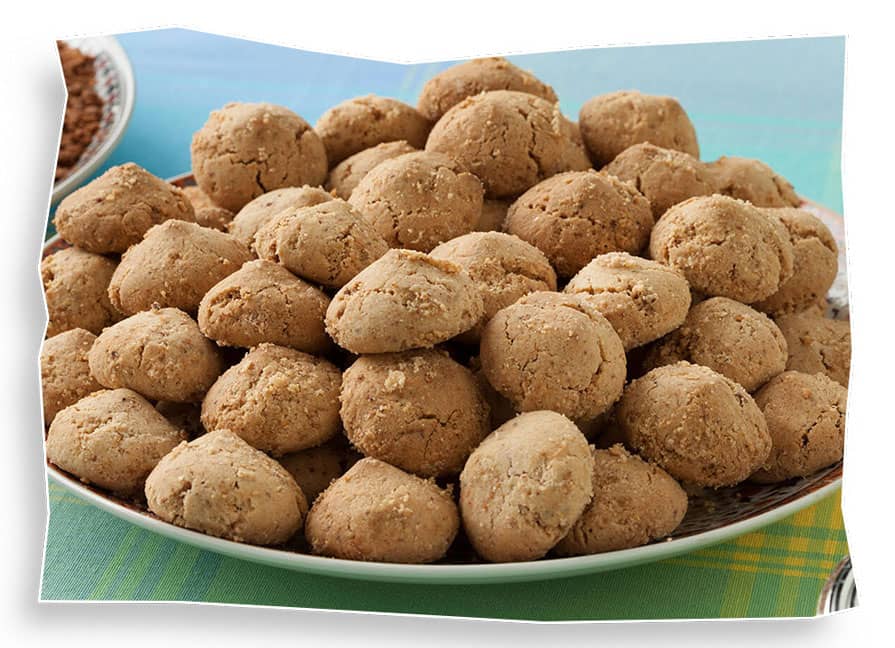
5. Kaab el Ghazal (Gazelle Horns):
This elegant pastry is shaped like a crescent and filled with almond paste sweetened with sugar and flavored with orange blossom water. The dough is thin and delicate, offering a perfect balance between the tender exterior and the rich, nutty filling. Kaab el Ghazal is often served at weddings and festive occasions.
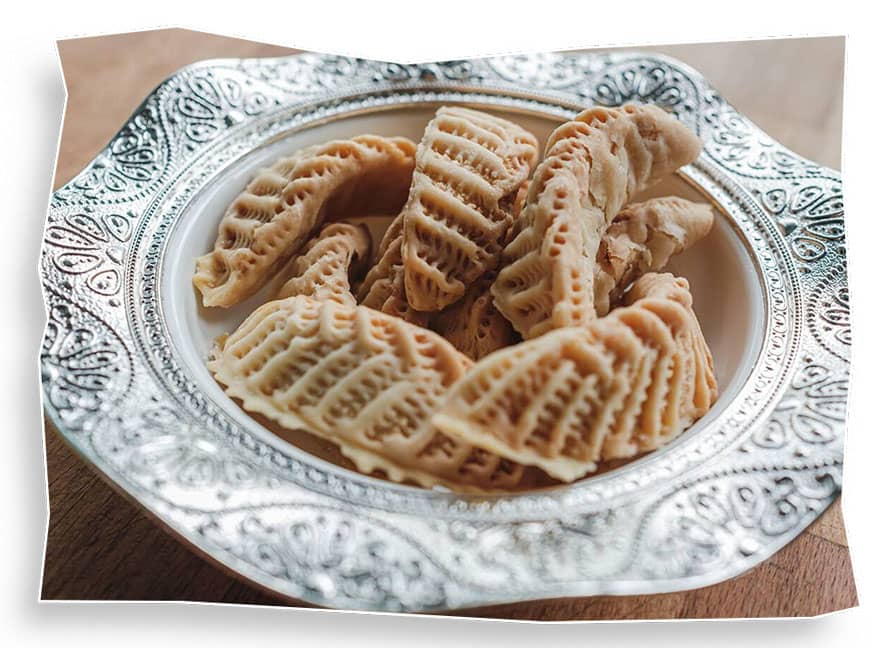
INDULGE IN MOROCCO’S MOST DELICIOUSLY SWEET TRADITIONS
From flaky almond-filled briouats to sticky honey-drenched chebakia, Moroccan desserts are a feast for the senses. Rooted in centuries of culinary heritage, these sweets blend warm spices, nuts, and floral waters into irresistible treats. Whether enjoyed with mint tea or during festive celebrations, each bite tells a story of tradition, hospitality, and pure indulgence.
1. Moroccan Mint Tea:
The quintessential Moroccan drink, mint tea is a sweet, aromatic blend of green tea, fresh spearmint leaves, and sugar. Served in small glasses, it’s poured from a height to create a frothy top, symbolizing hospitality and friendship. Mint tea’s refreshing and slightly bitter taste balances the sweetness of Moroccan desserts perfectly.
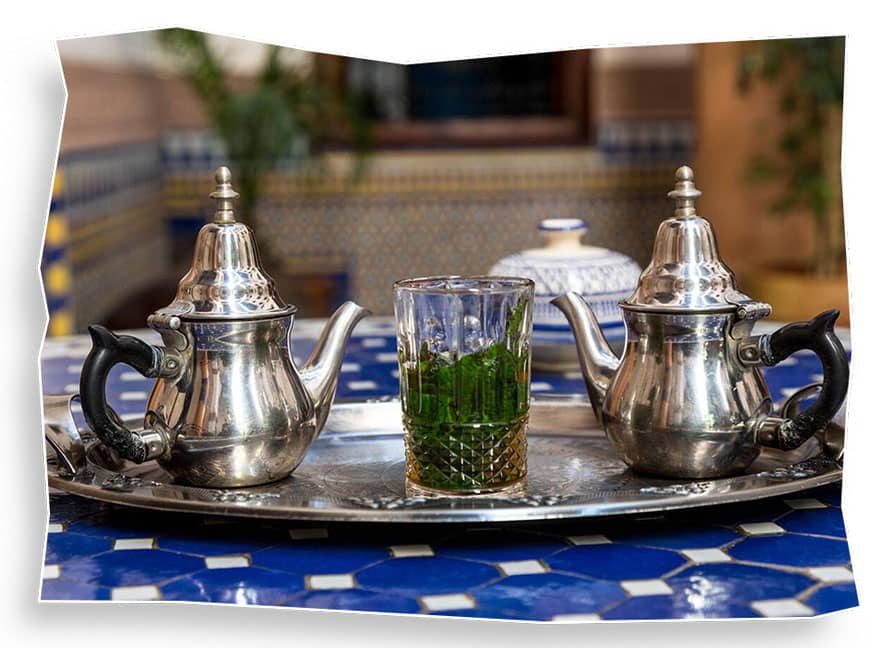
2. Almond Milk (Lben):
Almond milk, sometimes referred to as lben when fermented, is a refreshing drink often served alongside Moroccan sweets. Though less common than mint tea, it offers a creamy, cooling contrast—especially welcome during hot weather or celebrations. Vegan versions use blended almonds, water, and a touch of orange blossom or cinnamon. It’s both nourishing and subtly fragrant. Perfect for festive meals or as a light treat on warm days.
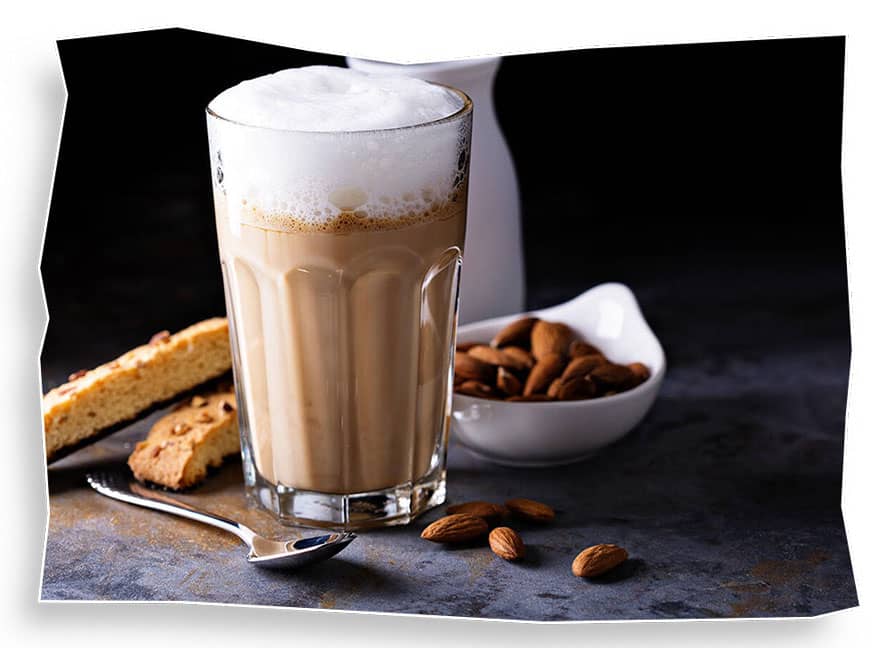
3. Spiced Hot Drinks:
In various Moroccan regions, spiced hot drinks are enjoyed as a comforting companion to desserts or during cool evenings. These beverages often feature warming spices like cinnamon, ginger, cloves, and sometimes star anise. Naturally vegan, they’re typically brewed with water or plant-based milk for a rich, aromatic flavor. The spices not only enhance taste but also aid digestion. These drinks add a cozy, fragrant touch to any Moroccan meal.

4. Serving Traditions:
Moroccan sweets are often presented on ornate trays, accompanied by tea poured from beautifully decorated teapots. Sharing sweets and tea is a communal activity that reflects Moroccan hospitality, especially during celebrations and family gatherings.
These beverages not only complement the rich flavors of Moroccan desserts but also play an important role in social rituals.
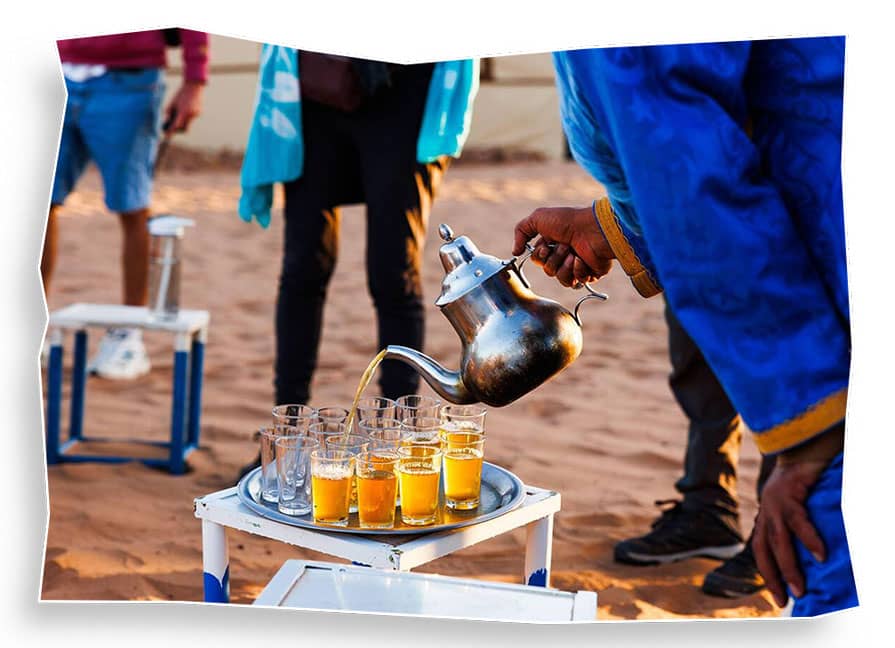
Regional Variations in Moroccan Sweets
Moroccan desserts are wonderfully diverse, with regional differences reflecting the country’s rich cultural tapestry and varying local ingredients.
1. Northern Morocco:
In regions like Fes and Tangier, desserts often feature Andalusian influences with delicate pastries filled with almond paste and flavored with rose water. The use of orange blossom water is prevalent, giving sweets a fragrant floral note. The north also embraces pastries like Kaab el Ghazal and M’hanncha.
2. Southern Morocco:
In areas such as Marrakech and the Sahara region, sweets tend to be richer and often incorporate dates, figs, and dried fruits reflecting the oasis agriculture. Sellou, with its dense nut and semolina base, is a favorite here. The south also uses more spices like cinnamon and anise, adding warmth and complexity.
3. Berber Influence:
The Berber communities contribute unique recipes and ingredients such as wild honey and nuts, and their sweets often emphasize natural, rustic flavors. Traditional honey-drenched pastries and simple, hearty desserts like Sellou highlight their culinary style.
4. Jewish Moroccan Sweets:
Jewish Moroccan communities have also left a mark on the country’s sweet traditions, with recipes for cookies and pastries that often include nuts and citrus flavors, further enriching the sweet landscape.
These regional differences add to the richness of Moroccan dessert traditions, inviting exploration and discovery beyond the familiar dishes.
How to Enjoy Moroccan Sweets: Occasions and Etiquette
Moroccan sweets are more than just treats they play a vital role in social and religious life, symbolizing hospitality, celebration, and community bonding.
1. Special Occasions and Festivals:
Moroccan desserts are central to celebrations such as Eid al-Fitr, Eid al-Adha, and weddings. During Ramadan, sweets like Chebakia are prepared in large quantities to break the fast with a burst of sweetness and energy. Weddings and family gatherings often feature an elaborate spread of pastries, cookies, and sweet drinks, emphasizing generosity and joy.
2. Hospitality Traditions:
Offering sweets alongside mint tea is a sign of warm hospitality. Guests are often welcomed with a beautifully arranged tray of assorted Moroccan desserts, symbolizing respect and friendship. It’s customary to enjoy these treats slowly, savoring each bite while engaging in conversation.
3. Portion Sizes and Sharing:
Moroccan sweets are typically rich and sweet, so portions are usually small often bite-sized. Sharing is encouraged, and sweets are passed around on communal trays, reinforcing social connections.
4. Pairing with Tea:
Moroccan mint tea is the perfect companion to sweets, as its slight bitterness balances the sugary richness. The act of pouring tea from a height, creating a frothy surface, is a traditional practice that adds elegance and ceremony to the experience.
By understanding these customs, you can fully appreciate Moroccan sweets not just as food, but as an integral part of cultural expression and connection.
conclusion
Moroccan desserts and sweets are a deliciously rich tradition that reflects the country’s diverse cultural heritage, artisanal craftsmanship, and love for flavor. From the honey-drizzled Chebakia to the delicate almond-filled Kaab el Ghazal, these treats offer a sensory journey filled with fragrant spices, nuts, and floral essences.
More than just food, Moroccan sweets symbolize hospitality, celebration, and family unity, playing a vital role in festivals and everyday life. Whether enjoyed in a bustling market, a quiet home, or alongside a glass of refreshing mint tea, these desserts invite you to experience the warmth and generosity of Moroccan culture.
Exploring Moroccan sweets is a wonderful way to connect with the country’s history and people and to satisfy your sweet tooth with truly unforgettable flavors.
